Project Plan: Reducing Overweight and Obesity in Brimbank, Australia
VerifiedAdded on 2022/10/12
|15
|3764
|410
Project
AI Summary
This project plan outlines a comprehensive health promotion initiative targeting overweight and obesity in the City of Brimbank, Australia. The plan addresses the high prevalence of obesity and related health issues by focusing on improving physical activity levels, promoting healthy dietary choices, and increasing awareness of health risks. It identifies key stakeholders, including community members, healthcare providers, and policymakers, and proposes specific objectives such as increasing participation in physical activity and improving knowledge of healthy eating habits. The project employs a health promotion belief model to influence perceptions about obesity and utilizes a leisure-time physical activity conceptual model to understand the factors influencing health behaviors. The plan includes strategies for educational campaigns, community engagement, and policy advocacy to create a supportive environment for healthy living and reduce the prevalence of overweight and obesity. The project aims to improve the overall health and well-being of the Brimbank community by addressing the social determinants of health and promoting preventive healthcare measures.

Project Plan 1
Project Plan
Name
Professor
Institution
Course
City, State
Date
Project Plan
Name
Professor
Institution
Course
City, State
Date
Secure Best Marks with AI Grader
Need help grading? Try our AI Grader for instant feedback on your assignments.
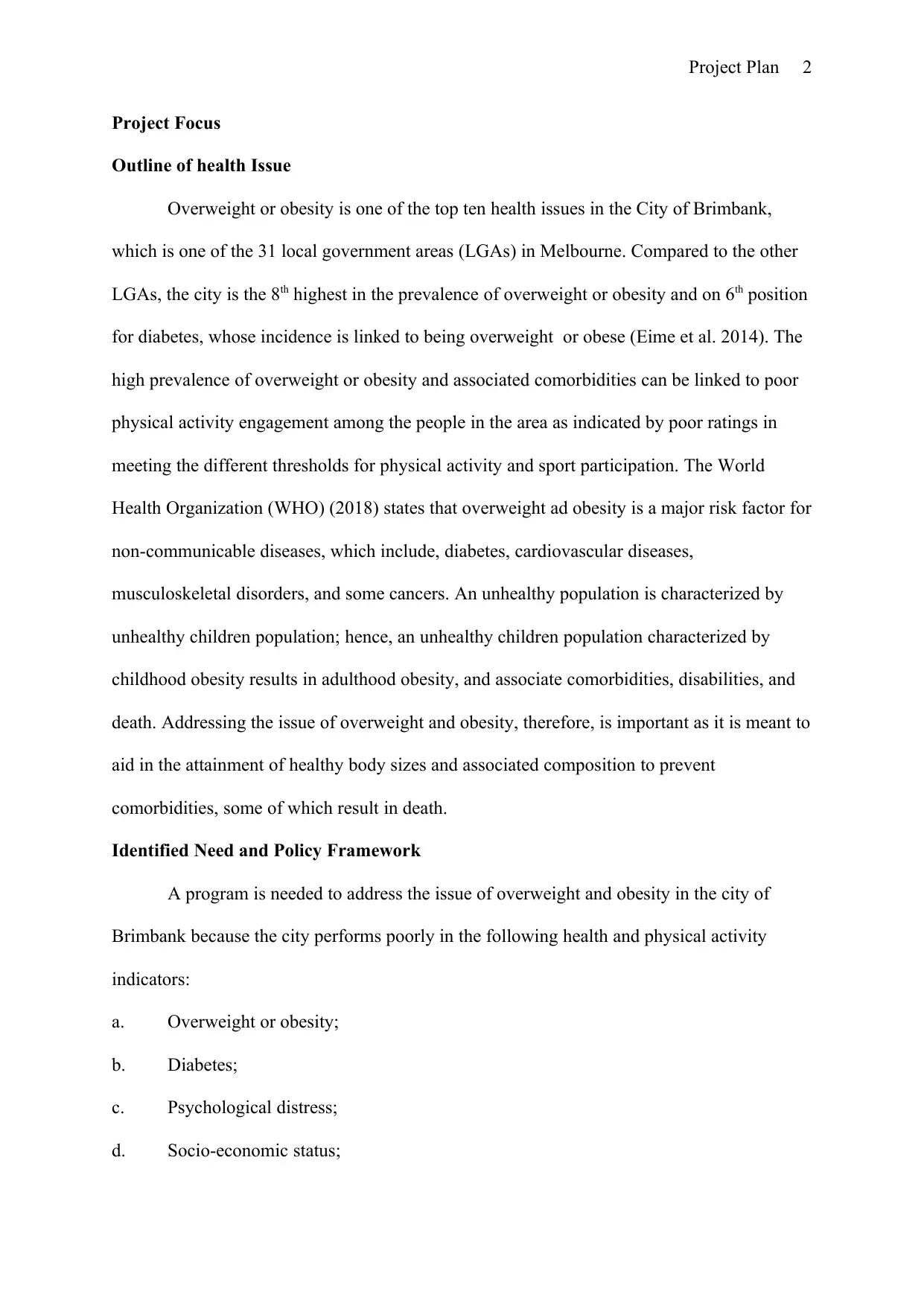
Project Plan 2
Project Focus
Outline of health Issue
Overweight or obesity is one of the top ten health issues in the City of Brimbank,
which is one of the 31 local government areas (LGAs) in Melbourne. Compared to the other
LGAs, the city is the 8th highest in the prevalence of overweight or obesity and on 6th position
for diabetes, whose incidence is linked to being overweight or obese (Eime et al. 2014). The
high prevalence of overweight or obesity and associated comorbidities can be linked to poor
physical activity engagement among the people in the area as indicated by poor ratings in
meeting the different thresholds for physical activity and sport participation. The World
Health Organization (WHO) (2018) states that overweight ad obesity is a major risk factor for
non-communicable diseases, which include, diabetes, cardiovascular diseases,
musculoskeletal disorders, and some cancers. An unhealthy population is characterized by
unhealthy children population; hence, an unhealthy children population characterized by
childhood obesity results in adulthood obesity, and associate comorbidities, disabilities, and
death. Addressing the issue of overweight and obesity, therefore, is important as it is meant to
aid in the attainment of healthy body sizes and associated composition to prevent
comorbidities, some of which result in death.
Identified Need and Policy Framework
A program is needed to address the issue of overweight and obesity in the city of
Brimbank because the city performs poorly in the following health and physical activity
indicators:
a. Overweight or obesity;
b. Diabetes;
c. Psychological distress;
d. Socio-economic status;
Project Focus
Outline of health Issue
Overweight or obesity is one of the top ten health issues in the City of Brimbank,
which is one of the 31 local government areas (LGAs) in Melbourne. Compared to the other
LGAs, the city is the 8th highest in the prevalence of overweight or obesity and on 6th position
for diabetes, whose incidence is linked to being overweight or obese (Eime et al. 2014). The
high prevalence of overweight or obesity and associated comorbidities can be linked to poor
physical activity engagement among the people in the area as indicated by poor ratings in
meeting the different thresholds for physical activity and sport participation. The World
Health Organization (WHO) (2018) states that overweight ad obesity is a major risk factor for
non-communicable diseases, which include, diabetes, cardiovascular diseases,
musculoskeletal disorders, and some cancers. An unhealthy population is characterized by
unhealthy children population; hence, an unhealthy children population characterized by
childhood obesity results in adulthood obesity, and associate comorbidities, disabilities, and
death. Addressing the issue of overweight and obesity, therefore, is important as it is meant to
aid in the attainment of healthy body sizes and associated composition to prevent
comorbidities, some of which result in death.
Identified Need and Policy Framework
A program is needed to address the issue of overweight and obesity in the city of
Brimbank because the city performs poorly in the following health and physical activity
indicators:
a. Overweight or obesity;
b. Diabetes;
c. Psychological distress;
d. Socio-economic status;
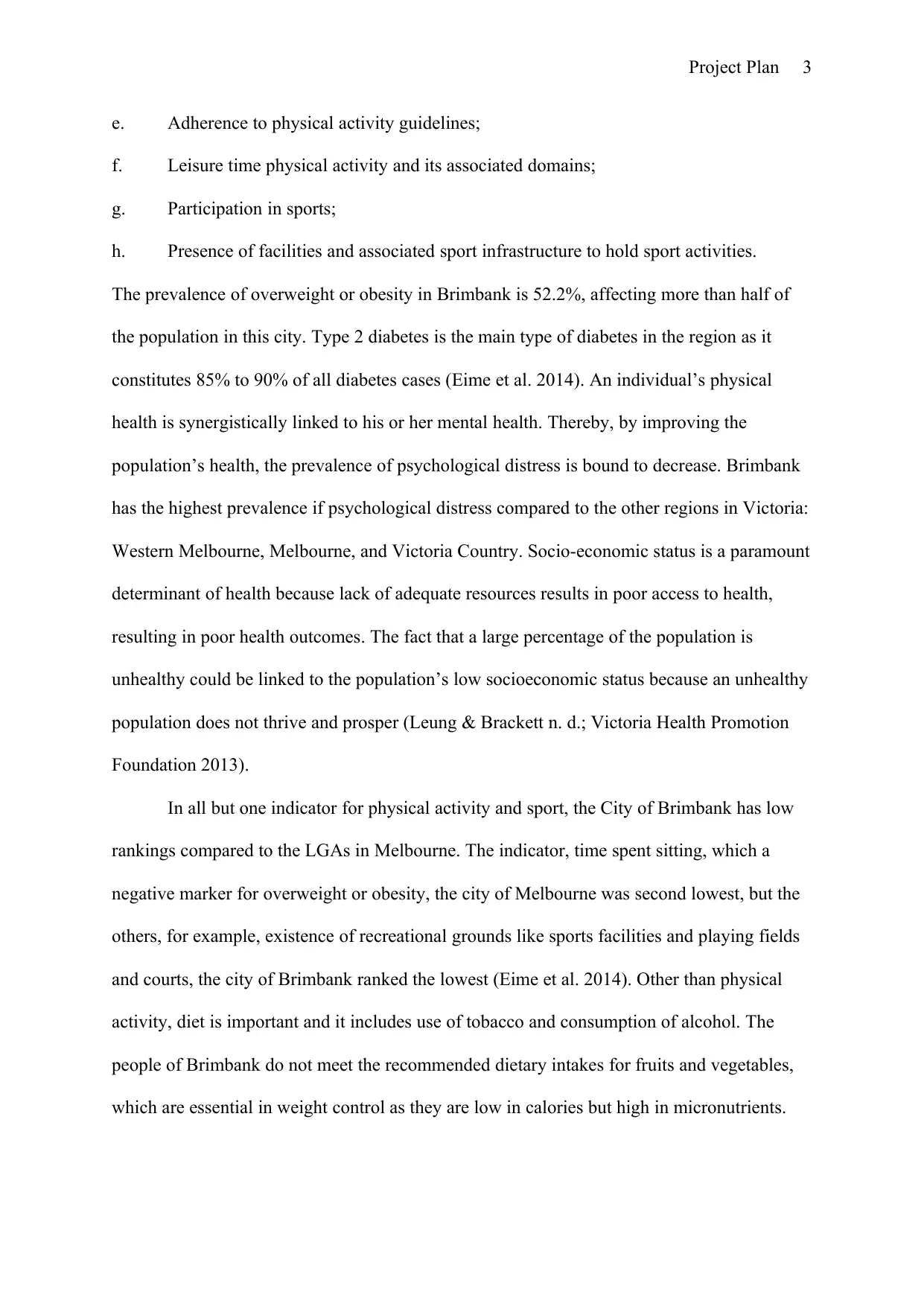
Project Plan 3
e. Adherence to physical activity guidelines;
f. Leisure time physical activity and its associated domains;
g. Participation in sports;
h. Presence of facilities and associated sport infrastructure to hold sport activities.
The prevalence of overweight or obesity in Brimbank is 52.2%, affecting more than half of
the population in this city. Type 2 diabetes is the main type of diabetes in the region as it
constitutes 85% to 90% of all diabetes cases (Eime et al. 2014). An individual’s physical
health is synergistically linked to his or her mental health. Thereby, by improving the
population’s health, the prevalence of psychological distress is bound to decrease. Brimbank
has the highest prevalence if psychological distress compared to the other regions in Victoria:
Western Melbourne, Melbourne, and Victoria Country. Socio-economic status is a paramount
determinant of health because lack of adequate resources results in poor access to health,
resulting in poor health outcomes. The fact that a large percentage of the population is
unhealthy could be linked to the population’s low socioeconomic status because an unhealthy
population does not thrive and prosper (Leung & Brackett n. d.; Victoria Health Promotion
Foundation 2013).
In all but one indicator for physical activity and sport, the City of Brimbank has low
rankings compared to the LGAs in Melbourne. The indicator, time spent sitting, which a
negative marker for overweight or obesity, the city of Melbourne was second lowest, but the
others, for example, existence of recreational grounds like sports facilities and playing fields
and courts, the city of Brimbank ranked the lowest (Eime et al. 2014). Other than physical
activity, diet is important and it includes use of tobacco and consumption of alcohol. The
people of Brimbank do not meet the recommended dietary intakes for fruits and vegetables,
which are essential in weight control as they are low in calories but high in micronutrients.
e. Adherence to physical activity guidelines;
f. Leisure time physical activity and its associated domains;
g. Participation in sports;
h. Presence of facilities and associated sport infrastructure to hold sport activities.
The prevalence of overweight or obesity in Brimbank is 52.2%, affecting more than half of
the population in this city. Type 2 diabetes is the main type of diabetes in the region as it
constitutes 85% to 90% of all diabetes cases (Eime et al. 2014). An individual’s physical
health is synergistically linked to his or her mental health. Thereby, by improving the
population’s health, the prevalence of psychological distress is bound to decrease. Brimbank
has the highest prevalence if psychological distress compared to the other regions in Victoria:
Western Melbourne, Melbourne, and Victoria Country. Socio-economic status is a paramount
determinant of health because lack of adequate resources results in poor access to health,
resulting in poor health outcomes. The fact that a large percentage of the population is
unhealthy could be linked to the population’s low socioeconomic status because an unhealthy
population does not thrive and prosper (Leung & Brackett n. d.; Victoria Health Promotion
Foundation 2013).
In all but one indicator for physical activity and sport, the City of Brimbank has low
rankings compared to the LGAs in Melbourne. The indicator, time spent sitting, which a
negative marker for overweight or obesity, the city of Melbourne was second lowest, but the
others, for example, existence of recreational grounds like sports facilities and playing fields
and courts, the city of Brimbank ranked the lowest (Eime et al. 2014). Other than physical
activity, diet is important and it includes use of tobacco and consumption of alcohol. The
people of Brimbank do not meet the recommended dietary intakes for fruits and vegetables,
which are essential in weight control as they are low in calories but high in micronutrients.
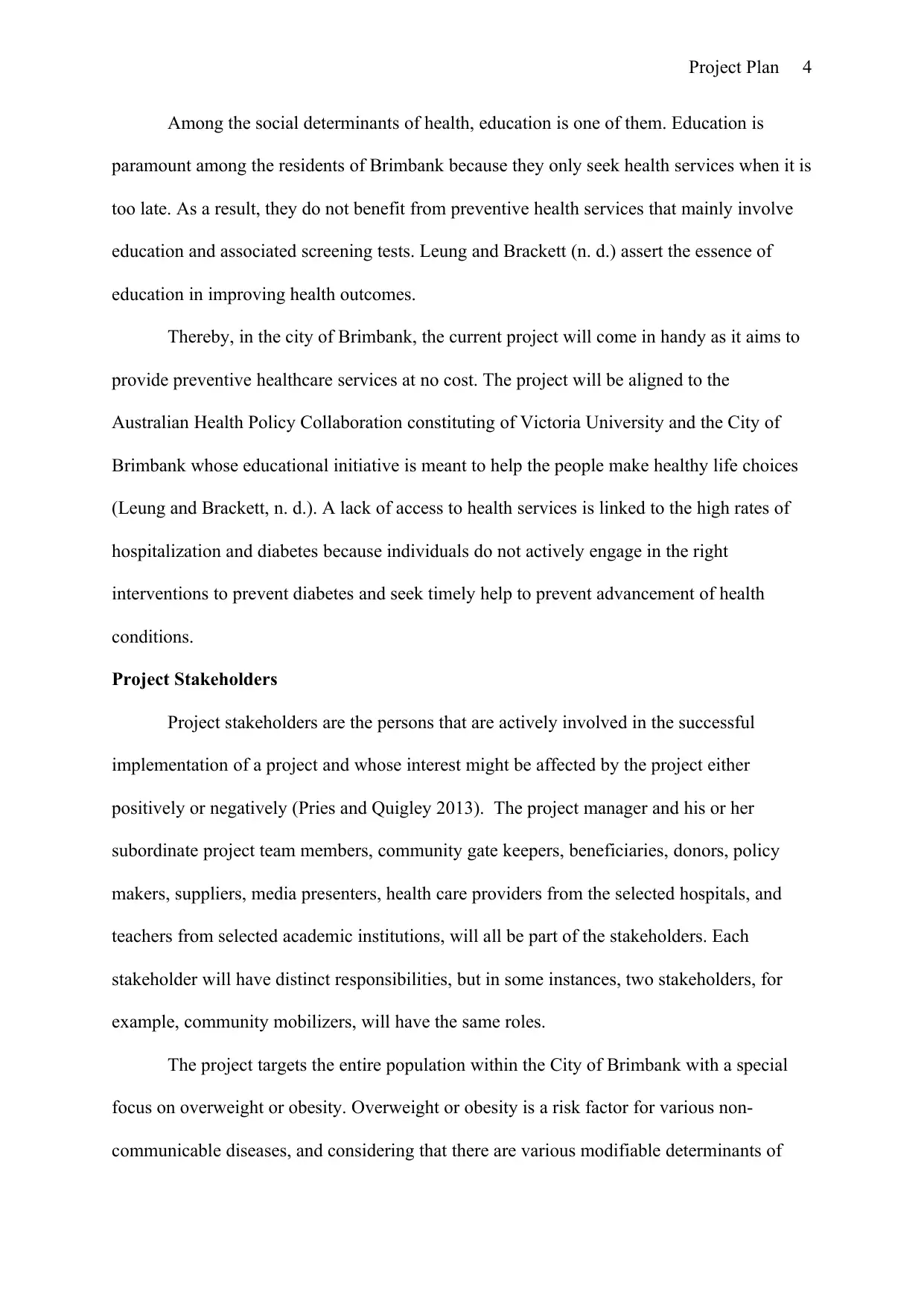
Project Plan 4
Among the social determinants of health, education is one of them. Education is
paramount among the residents of Brimbank because they only seek health services when it is
too late. As a result, they do not benefit from preventive health services that mainly involve
education and associated screening tests. Leung and Brackett (n. d.) assert the essence of
education in improving health outcomes.
Thereby, in the city of Brimbank, the current project will come in handy as it aims to
provide preventive healthcare services at no cost. The project will be aligned to the
Australian Health Policy Collaboration constituting of Victoria University and the City of
Brimbank whose educational initiative is meant to help the people make healthy life choices
(Leung and Brackett, n. d.). A lack of access to health services is linked to the high rates of
hospitalization and diabetes because individuals do not actively engage in the right
interventions to prevent diabetes and seek timely help to prevent advancement of health
conditions.
Project Stakeholders
Project stakeholders are the persons that are actively involved in the successful
implementation of a project and whose interest might be affected by the project either
positively or negatively (Pries and Quigley 2013). The project manager and his or her
subordinate project team members, community gate keepers, beneficiaries, donors, policy
makers, suppliers, media presenters, health care providers from the selected hospitals, and
teachers from selected academic institutions, will all be part of the stakeholders. Each
stakeholder will have distinct responsibilities, but in some instances, two stakeholders, for
example, community mobilizers, will have the same roles.
The project targets the entire population within the City of Brimbank with a special
focus on overweight or obesity. Overweight or obesity is a risk factor for various non-
communicable diseases, and considering that there are various modifiable determinants of
Among the social determinants of health, education is one of them. Education is
paramount among the residents of Brimbank because they only seek health services when it is
too late. As a result, they do not benefit from preventive health services that mainly involve
education and associated screening tests. Leung and Brackett (n. d.) assert the essence of
education in improving health outcomes.
Thereby, in the city of Brimbank, the current project will come in handy as it aims to
provide preventive healthcare services at no cost. The project will be aligned to the
Australian Health Policy Collaboration constituting of Victoria University and the City of
Brimbank whose educational initiative is meant to help the people make healthy life choices
(Leung and Brackett, n. d.). A lack of access to health services is linked to the high rates of
hospitalization and diabetes because individuals do not actively engage in the right
interventions to prevent diabetes and seek timely help to prevent advancement of health
conditions.
Project Stakeholders
Project stakeholders are the persons that are actively involved in the successful
implementation of a project and whose interest might be affected by the project either
positively or negatively (Pries and Quigley 2013). The project manager and his or her
subordinate project team members, community gate keepers, beneficiaries, donors, policy
makers, suppliers, media presenters, health care providers from the selected hospitals, and
teachers from selected academic institutions, will all be part of the stakeholders. Each
stakeholder will have distinct responsibilities, but in some instances, two stakeholders, for
example, community mobilizers, will have the same roles.
The project targets the entire population within the City of Brimbank with a special
focus on overweight or obesity. Overweight or obesity is a risk factor for various non-
communicable diseases, and considering that there are various modifiable determinants of
Secure Best Marks with AI Grader
Need help grading? Try our AI Grader for instant feedback on your assignments.
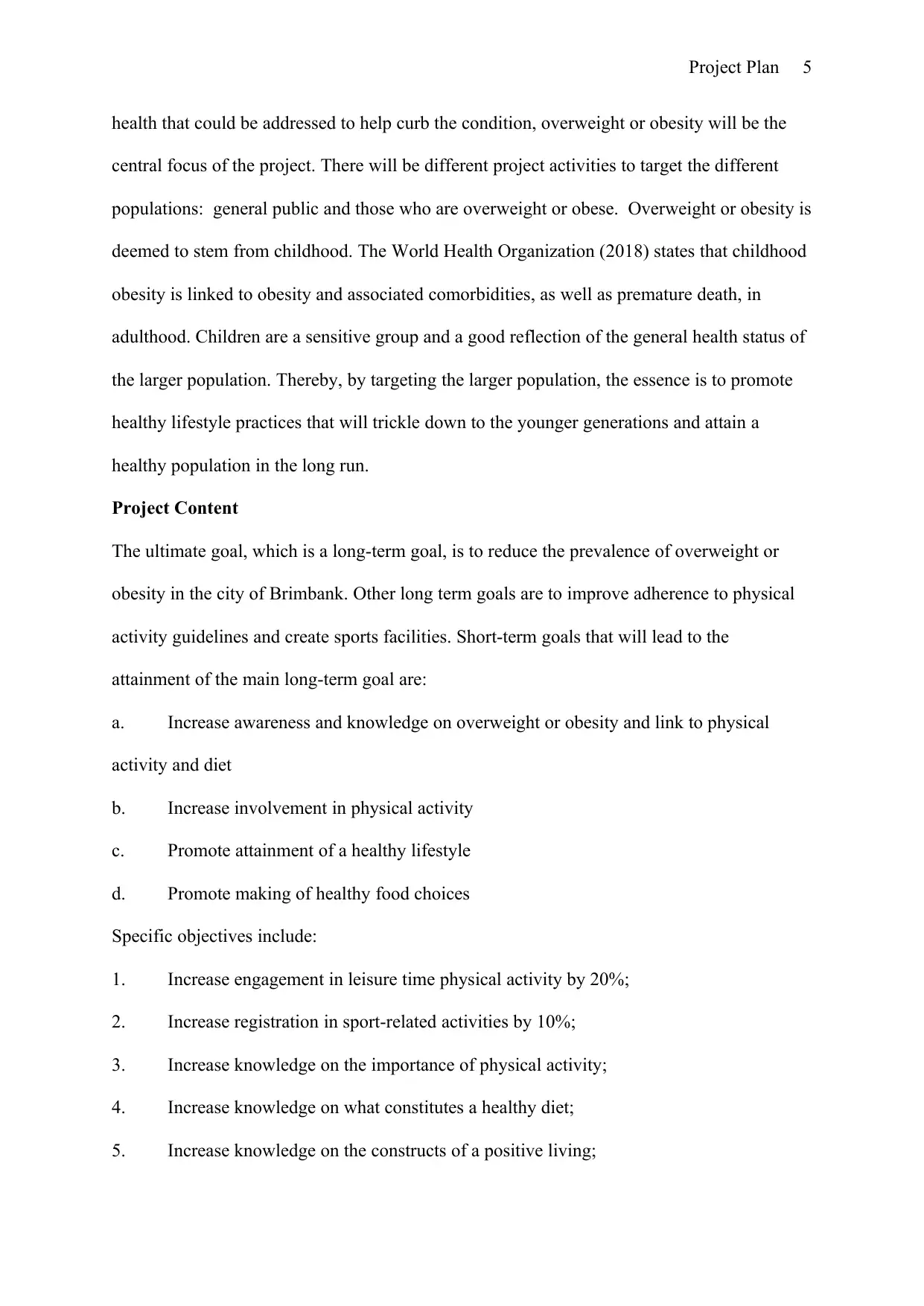
Project Plan 5
health that could be addressed to help curb the condition, overweight or obesity will be the
central focus of the project. There will be different project activities to target the different
populations: general public and those who are overweight or obese. Overweight or obesity is
deemed to stem from childhood. The World Health Organization (2018) states that childhood
obesity is linked to obesity and associated comorbidities, as well as premature death, in
adulthood. Children are a sensitive group and a good reflection of the general health status of
the larger population. Thereby, by targeting the larger population, the essence is to promote
healthy lifestyle practices that will trickle down to the younger generations and attain a
healthy population in the long run.
Project Content
The ultimate goal, which is a long-term goal, is to reduce the prevalence of overweight or
obesity in the city of Brimbank. Other long term goals are to improve adherence to physical
activity guidelines and create sports facilities. Short-term goals that will lead to the
attainment of the main long-term goal are:
a. Increase awareness and knowledge on overweight or obesity and link to physical
activity and diet
b. Increase involvement in physical activity
c. Promote attainment of a healthy lifestyle
d. Promote making of healthy food choices
Specific objectives include:
1. Increase engagement in leisure time physical activity by 20%;
2. Increase registration in sport-related activities by 10%;
3. Increase knowledge on the importance of physical activity;
4. Increase knowledge on what constitutes a healthy diet;
5. Increase knowledge on the constructs of a positive living;
health that could be addressed to help curb the condition, overweight or obesity will be the
central focus of the project. There will be different project activities to target the different
populations: general public and those who are overweight or obese. Overweight or obesity is
deemed to stem from childhood. The World Health Organization (2018) states that childhood
obesity is linked to obesity and associated comorbidities, as well as premature death, in
adulthood. Children are a sensitive group and a good reflection of the general health status of
the larger population. Thereby, by targeting the larger population, the essence is to promote
healthy lifestyle practices that will trickle down to the younger generations and attain a
healthy population in the long run.
Project Content
The ultimate goal, which is a long-term goal, is to reduce the prevalence of overweight or
obesity in the city of Brimbank. Other long term goals are to improve adherence to physical
activity guidelines and create sports facilities. Short-term goals that will lead to the
attainment of the main long-term goal are:
a. Increase awareness and knowledge on overweight or obesity and link to physical
activity and diet
b. Increase involvement in physical activity
c. Promote attainment of a healthy lifestyle
d. Promote making of healthy food choices
Specific objectives include:
1. Increase engagement in leisure time physical activity by 20%;
2. Increase registration in sport-related activities by 10%;
3. Increase knowledge on the importance of physical activity;
4. Increase knowledge on what constitutes a healthy diet;
5. Increase knowledge on the constructs of a positive living;

Project Plan 6
6. Increased servings of fruits and vegetables in the diet to the recommended servings.
Once again, it all comes down to the social determinants and consequences of poor health
status. In the current project, the population of Brimbank City is deemed to rank low in the
socioeconomic ladder and coupled with high health costs, they fail to access health. Thereby,
the population might be unaware of various concepts that could help them live positively and
prevent obesity, resulting in a healthy population. Increasing the population’s knowledge
about overweight or obesity is meant to promote the need for health seeking behavior that
will result in increased engagement in physical activity, increment in the ingestion of fruits
and vegetables, and adoption of other positive living practices, such as health diet and
smoking cessation. Also, the program seeks to involve pertinent figures responsible for policy
development. Thereby, such persons will help in the creation of sport infrastructure in the
long term, and subsequently adhere to the recommended physical activity guidelines based on
frequency of physical activity.
The markers of overweight and obesity have been used to formulate the specific
objectives because overweight or obese individuals often have additional lifestyle problems
other than physical activity and diet. Thereby, by highlighting positive living, behaviors like
smoking and alcohol consumption are included. Overweight or obese is as a result of energy
imbalance that can be regulated by a healthy diet and physical activity. Thereby, the
objectives have been formulated while factoring the three constructs highlighted in this
paragraph in mind.
Health Promotion Approach
Health promotion entails the increment in people’s control over their health. Health
promotion can be complex, involving legislature, and simple, limited to an organization. The
current health promotion activity will have a wide scope and it will be aligned to the
Brimbank Collaboration to improve health and education outcomes. The collaborative
6. Increased servings of fruits and vegetables in the diet to the recommended servings.
Once again, it all comes down to the social determinants and consequences of poor health
status. In the current project, the population of Brimbank City is deemed to rank low in the
socioeconomic ladder and coupled with high health costs, they fail to access health. Thereby,
the population might be unaware of various concepts that could help them live positively and
prevent obesity, resulting in a healthy population. Increasing the population’s knowledge
about overweight or obesity is meant to promote the need for health seeking behavior that
will result in increased engagement in physical activity, increment in the ingestion of fruits
and vegetables, and adoption of other positive living practices, such as health diet and
smoking cessation. Also, the program seeks to involve pertinent figures responsible for policy
development. Thereby, such persons will help in the creation of sport infrastructure in the
long term, and subsequently adhere to the recommended physical activity guidelines based on
frequency of physical activity.
The markers of overweight and obesity have been used to formulate the specific
objectives because overweight or obese individuals often have additional lifestyle problems
other than physical activity and diet. Thereby, by highlighting positive living, behaviors like
smoking and alcohol consumption are included. Overweight or obese is as a result of energy
imbalance that can be regulated by a healthy diet and physical activity. Thereby, the
objectives have been formulated while factoring the three constructs highlighted in this
paragraph in mind.
Health Promotion Approach
Health promotion entails the increment in people’s control over their health. Health
promotion can be complex, involving legislature, and simple, limited to an organization. The
current health promotion activity will have a wide scope and it will be aligned to the
Brimbank Collaboration to improve health and education outcomes. The collaborative
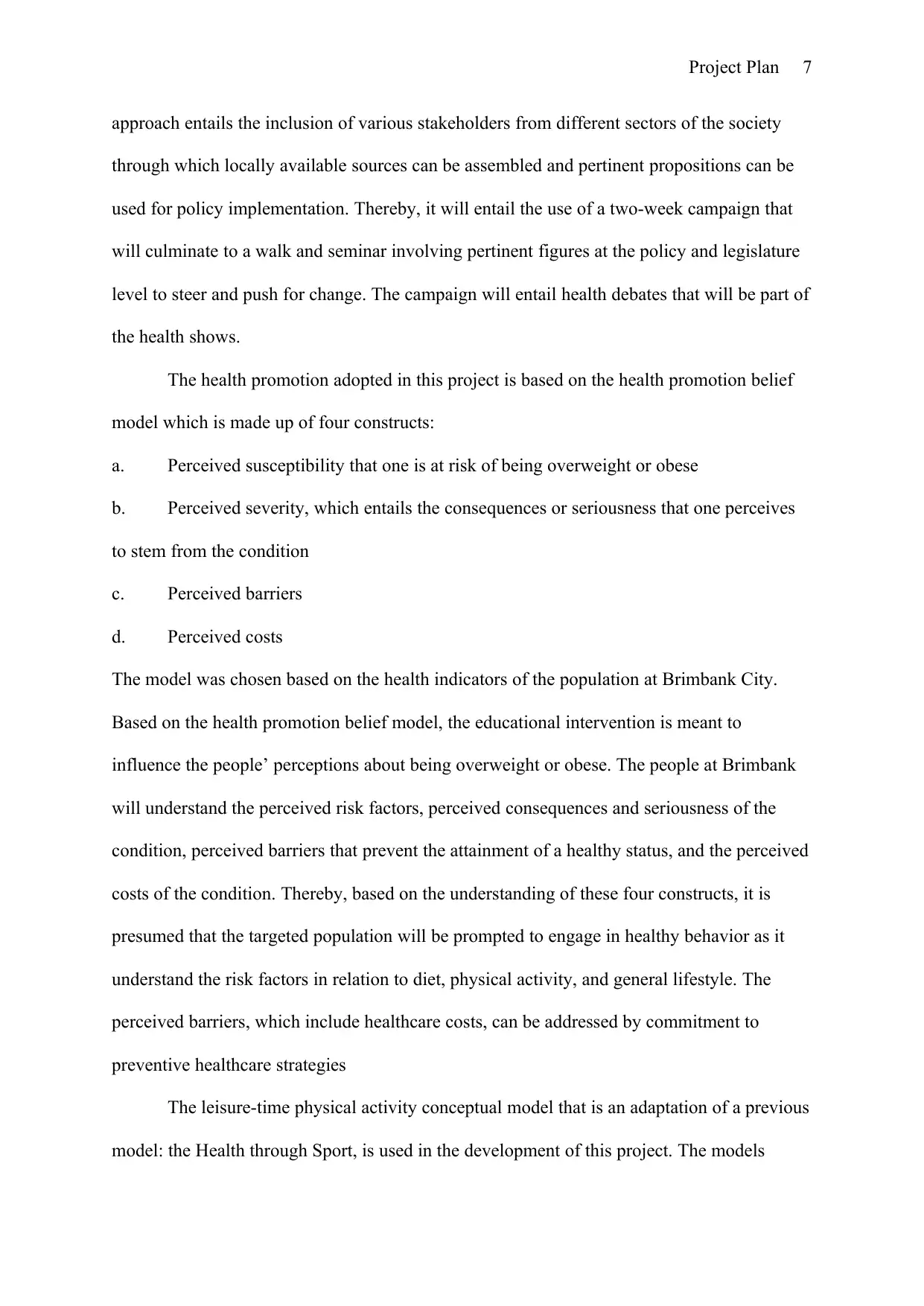
Project Plan 7
approach entails the inclusion of various stakeholders from different sectors of the society
through which locally available sources can be assembled and pertinent propositions can be
used for policy implementation. Thereby, it will entail the use of a two-week campaign that
will culminate to a walk and seminar involving pertinent figures at the policy and legislature
level to steer and push for change. The campaign will entail health debates that will be part of
the health shows.
The health promotion adopted in this project is based on the health promotion belief
model which is made up of four constructs:
a. Perceived susceptibility that one is at risk of being overweight or obese
b. Perceived severity, which entails the consequences or seriousness that one perceives
to stem from the condition
c. Perceived barriers
d. Perceived costs
The model was chosen based on the health indicators of the population at Brimbank City.
Based on the health promotion belief model, the educational intervention is meant to
influence the people’ perceptions about being overweight or obese. The people at Brimbank
will understand the perceived risk factors, perceived consequences and seriousness of the
condition, perceived barriers that prevent the attainment of a healthy status, and the perceived
costs of the condition. Thereby, based on the understanding of these four constructs, it is
presumed that the targeted population will be prompted to engage in healthy behavior as it
understand the risk factors in relation to diet, physical activity, and general lifestyle. The
perceived barriers, which include healthcare costs, can be addressed by commitment to
preventive healthcare strategies
The leisure-time physical activity conceptual model that is an adaptation of a previous
model: the Health through Sport, is used in the development of this project. The models
approach entails the inclusion of various stakeholders from different sectors of the society
through which locally available sources can be assembled and pertinent propositions can be
used for policy implementation. Thereby, it will entail the use of a two-week campaign that
will culminate to a walk and seminar involving pertinent figures at the policy and legislature
level to steer and push for change. The campaign will entail health debates that will be part of
the health shows.
The health promotion adopted in this project is based on the health promotion belief
model which is made up of four constructs:
a. Perceived susceptibility that one is at risk of being overweight or obese
b. Perceived severity, which entails the consequences or seriousness that one perceives
to stem from the condition
c. Perceived barriers
d. Perceived costs
The model was chosen based on the health indicators of the population at Brimbank City.
Based on the health promotion belief model, the educational intervention is meant to
influence the people’ perceptions about being overweight or obese. The people at Brimbank
will understand the perceived risk factors, perceived consequences and seriousness of the
condition, perceived barriers that prevent the attainment of a healthy status, and the perceived
costs of the condition. Thereby, based on the understanding of these four constructs, it is
presumed that the targeted population will be prompted to engage in healthy behavior as it
understand the risk factors in relation to diet, physical activity, and general lifestyle. The
perceived barriers, which include healthcare costs, can be addressed by commitment to
preventive healthcare strategies
The leisure-time physical activity conceptual model that is an adaptation of a previous
model: the Health through Sport, is used in the development of this project. The models
Paraphrase This Document
Need a fresh take? Get an instant paraphrase of this document with our AI Paraphraser
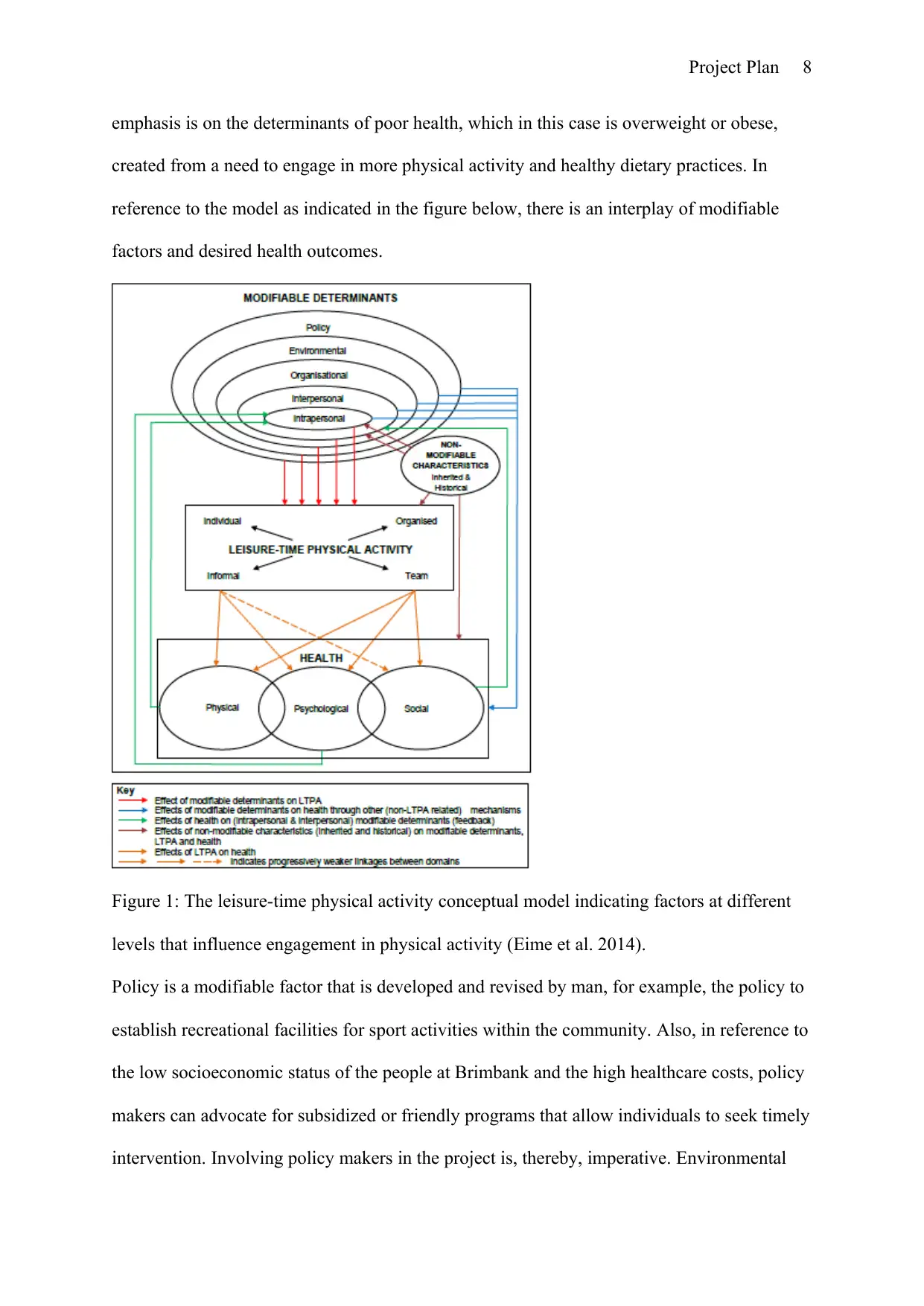
Project Plan 8
emphasis is on the determinants of poor health, which in this case is overweight or obese,
created from a need to engage in more physical activity and healthy dietary practices. In
reference to the model as indicated in the figure below, there is an interplay of modifiable
factors and desired health outcomes.
Figure 1: The leisure-time physical activity conceptual model indicating factors at different
levels that influence engagement in physical activity (Eime et al. 2014).
Policy is a modifiable factor that is developed and revised by man, for example, the policy to
establish recreational facilities for sport activities within the community. Also, in reference to
the low socioeconomic status of the people at Brimbank and the high healthcare costs, policy
makers can advocate for subsidized or friendly programs that allow individuals to seek timely
intervention. Involving policy makers in the project is, thereby, imperative. Environmental
emphasis is on the determinants of poor health, which in this case is overweight or obese,
created from a need to engage in more physical activity and healthy dietary practices. In
reference to the model as indicated in the figure below, there is an interplay of modifiable
factors and desired health outcomes.
Figure 1: The leisure-time physical activity conceptual model indicating factors at different
levels that influence engagement in physical activity (Eime et al. 2014).
Policy is a modifiable factor that is developed and revised by man, for example, the policy to
establish recreational facilities for sport activities within the community. Also, in reference to
the low socioeconomic status of the people at Brimbank and the high healthcare costs, policy
makers can advocate for subsidized or friendly programs that allow individuals to seek timely
intervention. Involving policy makers in the project is, thereby, imperative. Environmental
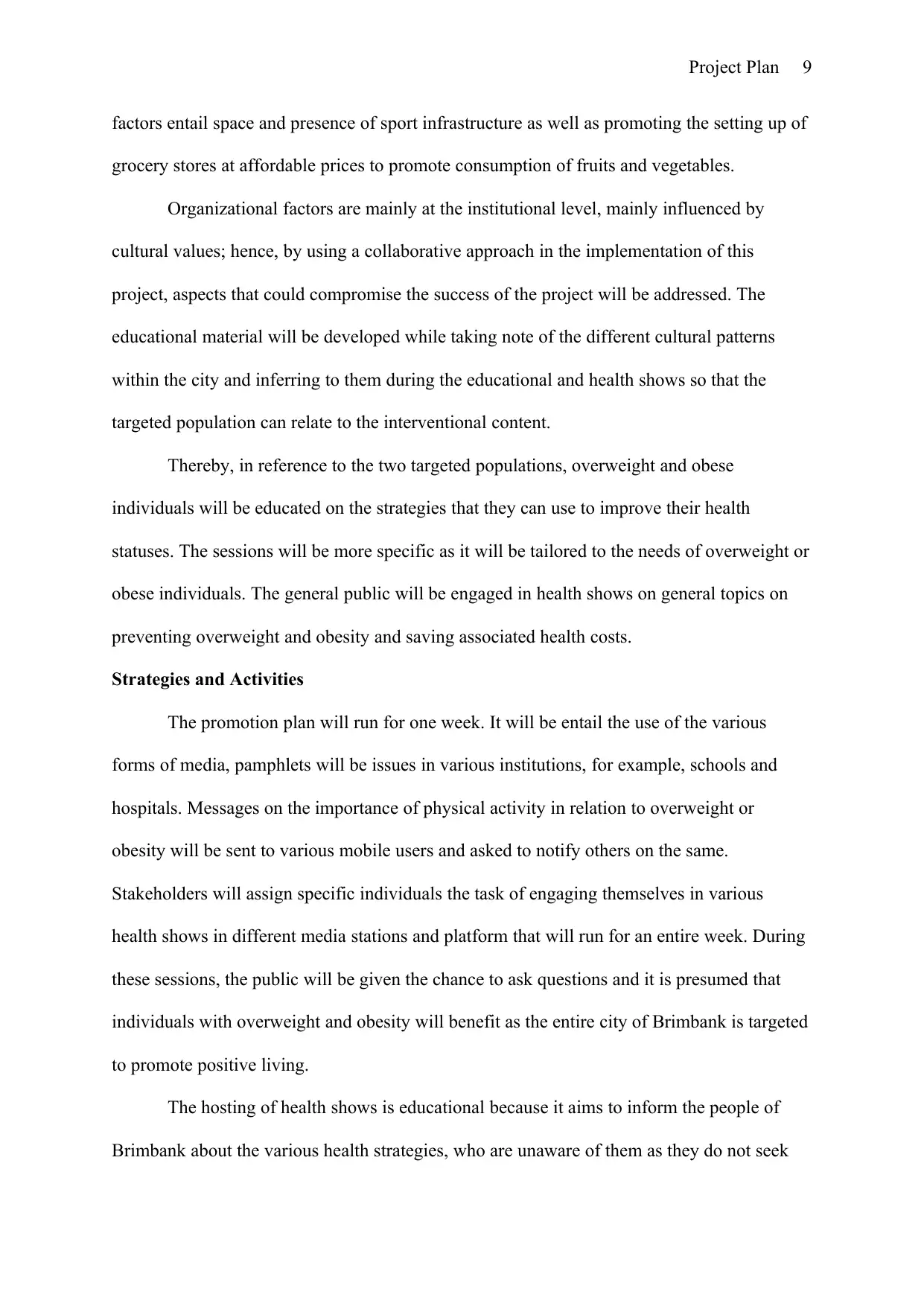
Project Plan 9
factors entail space and presence of sport infrastructure as well as promoting the setting up of
grocery stores at affordable prices to promote consumption of fruits and vegetables.
Organizational factors are mainly at the institutional level, mainly influenced by
cultural values; hence, by using a collaborative approach in the implementation of this
project, aspects that could compromise the success of the project will be addressed. The
educational material will be developed while taking note of the different cultural patterns
within the city and inferring to them during the educational and health shows so that the
targeted population can relate to the interventional content.
Thereby, in reference to the two targeted populations, overweight and obese
individuals will be educated on the strategies that they can use to improve their health
statuses. The sessions will be more specific as it will be tailored to the needs of overweight or
obese individuals. The general public will be engaged in health shows on general topics on
preventing overweight and obesity and saving associated health costs.
Strategies and Activities
The promotion plan will run for one week. It will be entail the use of the various
forms of media, pamphlets will be issues in various institutions, for example, schools and
hospitals. Messages on the importance of physical activity in relation to overweight or
obesity will be sent to various mobile users and asked to notify others on the same.
Stakeholders will assign specific individuals the task of engaging themselves in various
health shows in different media stations and platform that will run for an entire week. During
these sessions, the public will be given the chance to ask questions and it is presumed that
individuals with overweight and obesity will benefit as the entire city of Brimbank is targeted
to promote positive living.
The hosting of health shows is educational because it aims to inform the people of
Brimbank about the various health strategies, who are unaware of them as they do not seek
factors entail space and presence of sport infrastructure as well as promoting the setting up of
grocery stores at affordable prices to promote consumption of fruits and vegetables.
Organizational factors are mainly at the institutional level, mainly influenced by
cultural values; hence, by using a collaborative approach in the implementation of this
project, aspects that could compromise the success of the project will be addressed. The
educational material will be developed while taking note of the different cultural patterns
within the city and inferring to them during the educational and health shows so that the
targeted population can relate to the interventional content.
Thereby, in reference to the two targeted populations, overweight and obese
individuals will be educated on the strategies that they can use to improve their health
statuses. The sessions will be more specific as it will be tailored to the needs of overweight or
obese individuals. The general public will be engaged in health shows on general topics on
preventing overweight and obesity and saving associated health costs.
Strategies and Activities
The promotion plan will run for one week. It will be entail the use of the various
forms of media, pamphlets will be issues in various institutions, for example, schools and
hospitals. Messages on the importance of physical activity in relation to overweight or
obesity will be sent to various mobile users and asked to notify others on the same.
Stakeholders will assign specific individuals the task of engaging themselves in various
health shows in different media stations and platform that will run for an entire week. During
these sessions, the public will be given the chance to ask questions and it is presumed that
individuals with overweight and obesity will benefit as the entire city of Brimbank is targeted
to promote positive living.
The hosting of health shows is educational because it aims to inform the people of
Brimbank about the various health strategies, who are unaware of them as they do not seek
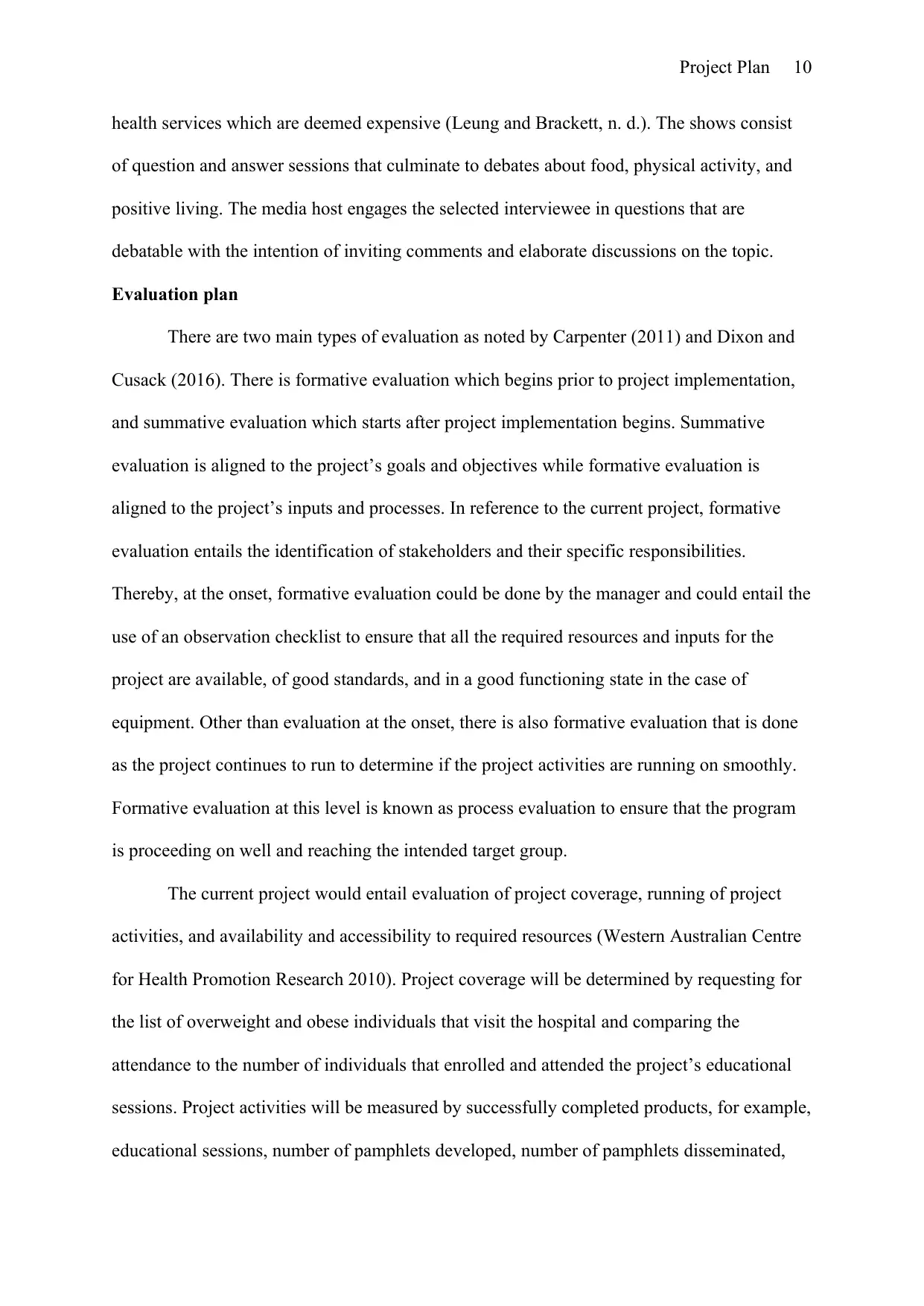
Project Plan 10
health services which are deemed expensive (Leung and Brackett, n. d.). The shows consist
of question and answer sessions that culminate to debates about food, physical activity, and
positive living. The media host engages the selected interviewee in questions that are
debatable with the intention of inviting comments and elaborate discussions on the topic.
Evaluation plan
There are two main types of evaluation as noted by Carpenter (2011) and Dixon and
Cusack (2016). There is formative evaluation which begins prior to project implementation,
and summative evaluation which starts after project implementation begins. Summative
evaluation is aligned to the project’s goals and objectives while formative evaluation is
aligned to the project’s inputs and processes. In reference to the current project, formative
evaluation entails the identification of stakeholders and their specific responsibilities.
Thereby, at the onset, formative evaluation could be done by the manager and could entail the
use of an observation checklist to ensure that all the required resources and inputs for the
project are available, of good standards, and in a good functioning state in the case of
equipment. Other than evaluation at the onset, there is also formative evaluation that is done
as the project continues to run to determine if the project activities are running on smoothly.
Formative evaluation at this level is known as process evaluation to ensure that the program
is proceeding on well and reaching the intended target group.
The current project would entail evaluation of project coverage, running of project
activities, and availability and accessibility to required resources (Western Australian Centre
for Health Promotion Research 2010). Project coverage will be determined by requesting for
the list of overweight and obese individuals that visit the hospital and comparing the
attendance to the number of individuals that enrolled and attended the project’s educational
sessions. Project activities will be measured by successfully completed products, for example,
educational sessions, number of pamphlets developed, number of pamphlets disseminated,
health services which are deemed expensive (Leung and Brackett, n. d.). The shows consist
of question and answer sessions that culminate to debates about food, physical activity, and
positive living. The media host engages the selected interviewee in questions that are
debatable with the intention of inviting comments and elaborate discussions on the topic.
Evaluation plan
There are two main types of evaluation as noted by Carpenter (2011) and Dixon and
Cusack (2016). There is formative evaluation which begins prior to project implementation,
and summative evaluation which starts after project implementation begins. Summative
evaluation is aligned to the project’s goals and objectives while formative evaluation is
aligned to the project’s inputs and processes. In reference to the current project, formative
evaluation entails the identification of stakeholders and their specific responsibilities.
Thereby, at the onset, formative evaluation could be done by the manager and could entail the
use of an observation checklist to ensure that all the required resources and inputs for the
project are available, of good standards, and in a good functioning state in the case of
equipment. Other than evaluation at the onset, there is also formative evaluation that is done
as the project continues to run to determine if the project activities are running on smoothly.
Formative evaluation at this level is known as process evaluation to ensure that the program
is proceeding on well and reaching the intended target group.
The current project would entail evaluation of project coverage, running of project
activities, and availability and accessibility to required resources (Western Australian Centre
for Health Promotion Research 2010). Project coverage will be determined by requesting for
the list of overweight and obese individuals that visit the hospital and comparing the
attendance to the number of individuals that enrolled and attended the project’s educational
sessions. Project activities will be measured by successfully completed products, for example,
educational sessions, number of pamphlets developed, number of pamphlets disseminated,
Secure Best Marks with AI Grader
Need help grading? Try our AI Grader for instant feedback on your assignments.
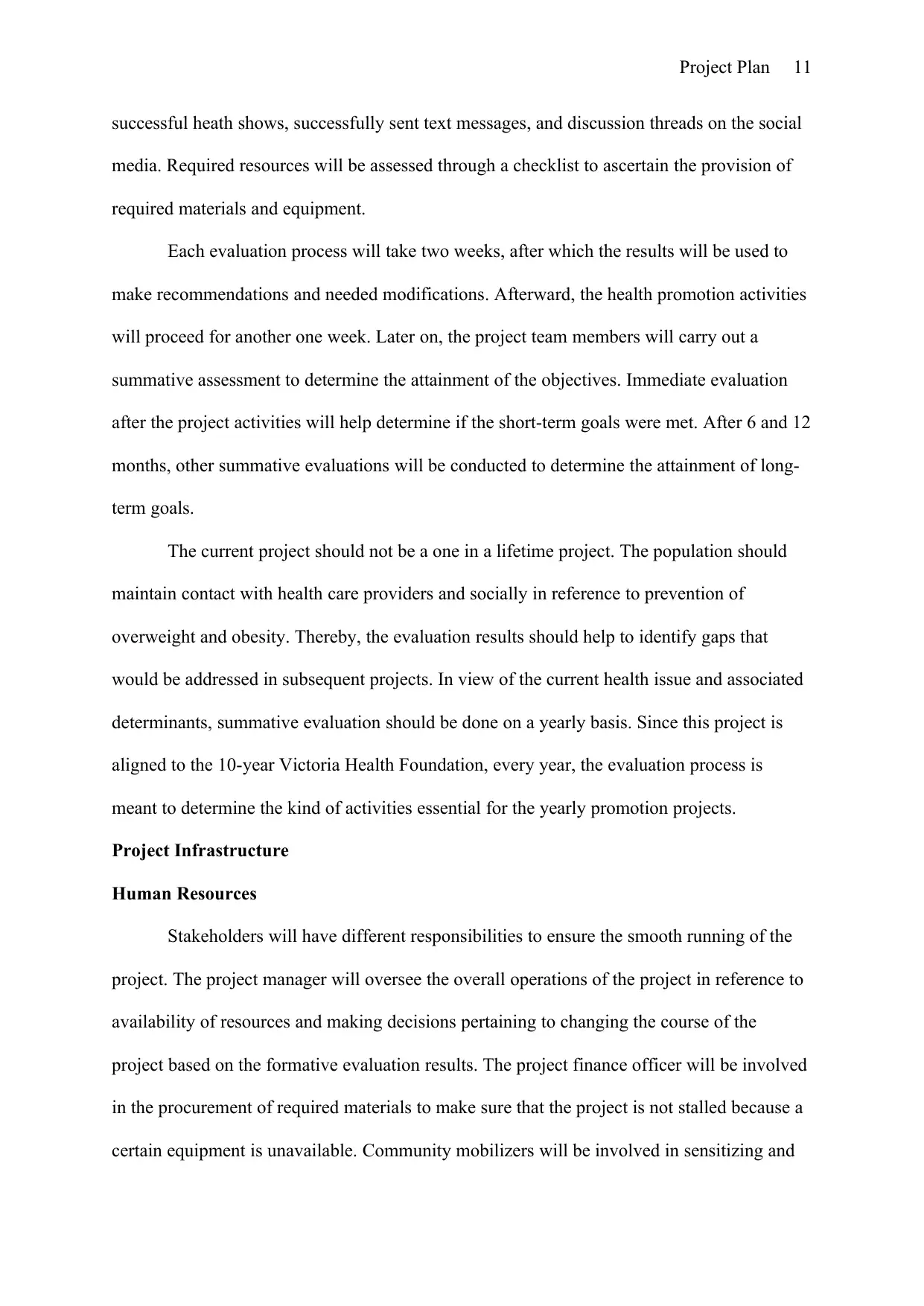
Project Plan 11
successful heath shows, successfully sent text messages, and discussion threads on the social
media. Required resources will be assessed through a checklist to ascertain the provision of
required materials and equipment.
Each evaluation process will take two weeks, after which the results will be used to
make recommendations and needed modifications. Afterward, the health promotion activities
will proceed for another one week. Later on, the project team members will carry out a
summative assessment to determine the attainment of the objectives. Immediate evaluation
after the project activities will help determine if the short-term goals were met. After 6 and 12
months, other summative evaluations will be conducted to determine the attainment of long-
term goals.
The current project should not be a one in a lifetime project. The population should
maintain contact with health care providers and socially in reference to prevention of
overweight and obesity. Thereby, the evaluation results should help to identify gaps that
would be addressed in subsequent projects. In view of the current health issue and associated
determinants, summative evaluation should be done on a yearly basis. Since this project is
aligned to the 10-year Victoria Health Foundation, every year, the evaluation process is
meant to determine the kind of activities essential for the yearly promotion projects.
Project Infrastructure
Human Resources
Stakeholders will have different responsibilities to ensure the smooth running of the
project. The project manager will oversee the overall operations of the project in reference to
availability of resources and making decisions pertaining to changing the course of the
project based on the formative evaluation results. The project finance officer will be involved
in the procurement of required materials to make sure that the project is not stalled because a
certain equipment is unavailable. Community mobilizers will be involved in sensitizing and
successful heath shows, successfully sent text messages, and discussion threads on the social
media. Required resources will be assessed through a checklist to ascertain the provision of
required materials and equipment.
Each evaluation process will take two weeks, after which the results will be used to
make recommendations and needed modifications. Afterward, the health promotion activities
will proceed for another one week. Later on, the project team members will carry out a
summative assessment to determine the attainment of the objectives. Immediate evaluation
after the project activities will help determine if the short-term goals were met. After 6 and 12
months, other summative evaluations will be conducted to determine the attainment of long-
term goals.
The current project should not be a one in a lifetime project. The population should
maintain contact with health care providers and socially in reference to prevention of
overweight and obesity. Thereby, the evaluation results should help to identify gaps that
would be addressed in subsequent projects. In view of the current health issue and associated
determinants, summative evaluation should be done on a yearly basis. Since this project is
aligned to the 10-year Victoria Health Foundation, every year, the evaluation process is
meant to determine the kind of activities essential for the yearly promotion projects.
Project Infrastructure
Human Resources
Stakeholders will have different responsibilities to ensure the smooth running of the
project. The project manager will oversee the overall operations of the project in reference to
availability of resources and making decisions pertaining to changing the course of the
project based on the formative evaluation results. The project finance officer will be involved
in the procurement of required materials to make sure that the project is not stalled because a
certain equipment is unavailable. Community mobilizers will be involved in sensitizing and
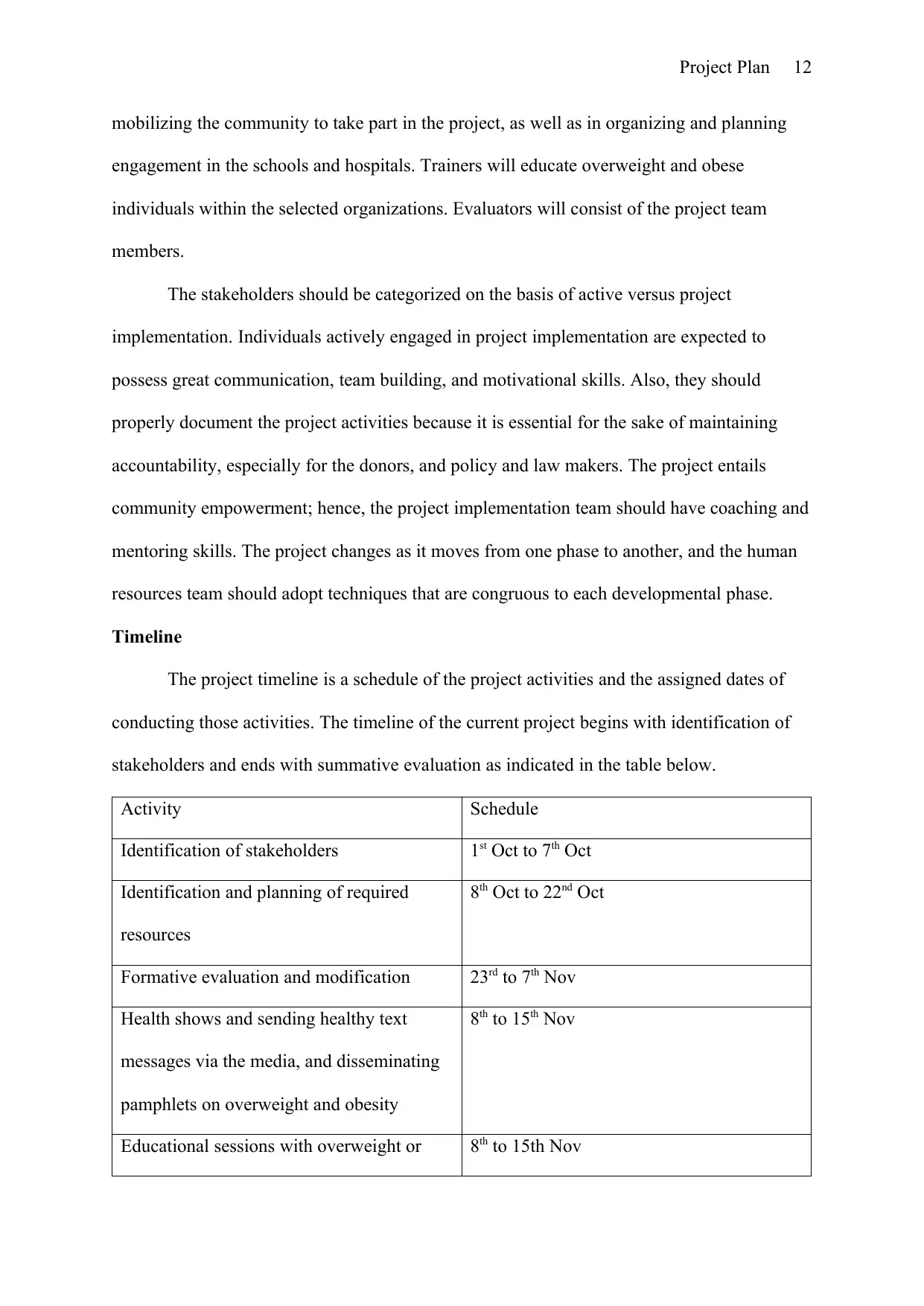
Project Plan 12
mobilizing the community to take part in the project, as well as in organizing and planning
engagement in the schools and hospitals. Trainers will educate overweight and obese
individuals within the selected organizations. Evaluators will consist of the project team
members.
The stakeholders should be categorized on the basis of active versus project
implementation. Individuals actively engaged in project implementation are expected to
possess great communication, team building, and motivational skills. Also, they should
properly document the project activities because it is essential for the sake of maintaining
accountability, especially for the donors, and policy and law makers. The project entails
community empowerment; hence, the project implementation team should have coaching and
mentoring skills. The project changes as it moves from one phase to another, and the human
resources team should adopt techniques that are congruous to each developmental phase.
Timeline
The project timeline is a schedule of the project activities and the assigned dates of
conducting those activities. The timeline of the current project begins with identification of
stakeholders and ends with summative evaluation as indicated in the table below.
Activity Schedule
Identification of stakeholders 1st Oct to 7th Oct
Identification and planning of required
resources
8th Oct to 22nd Oct
Formative evaluation and modification 23rd to 7th Nov
Health shows and sending healthy text
messages via the media, and disseminating
pamphlets on overweight and obesity
8th to 15th Nov
Educational sessions with overweight or 8th to 15th Nov
mobilizing the community to take part in the project, as well as in organizing and planning
engagement in the schools and hospitals. Trainers will educate overweight and obese
individuals within the selected organizations. Evaluators will consist of the project team
members.
The stakeholders should be categorized on the basis of active versus project
implementation. Individuals actively engaged in project implementation are expected to
possess great communication, team building, and motivational skills. Also, they should
properly document the project activities because it is essential for the sake of maintaining
accountability, especially for the donors, and policy and law makers. The project entails
community empowerment; hence, the project implementation team should have coaching and
mentoring skills. The project changes as it moves from one phase to another, and the human
resources team should adopt techniques that are congruous to each developmental phase.
Timeline
The project timeline is a schedule of the project activities and the assigned dates of
conducting those activities. The timeline of the current project begins with identification of
stakeholders and ends with summative evaluation as indicated in the table below.
Activity Schedule
Identification of stakeholders 1st Oct to 7th Oct
Identification and planning of required
resources
8th Oct to 22nd Oct
Formative evaluation and modification 23rd to 7th Nov
Health shows and sending healthy text
messages via the media, and disseminating
pamphlets on overweight and obesity
8th to 15th Nov
Educational sessions with overweight or 8th to 15th Nov
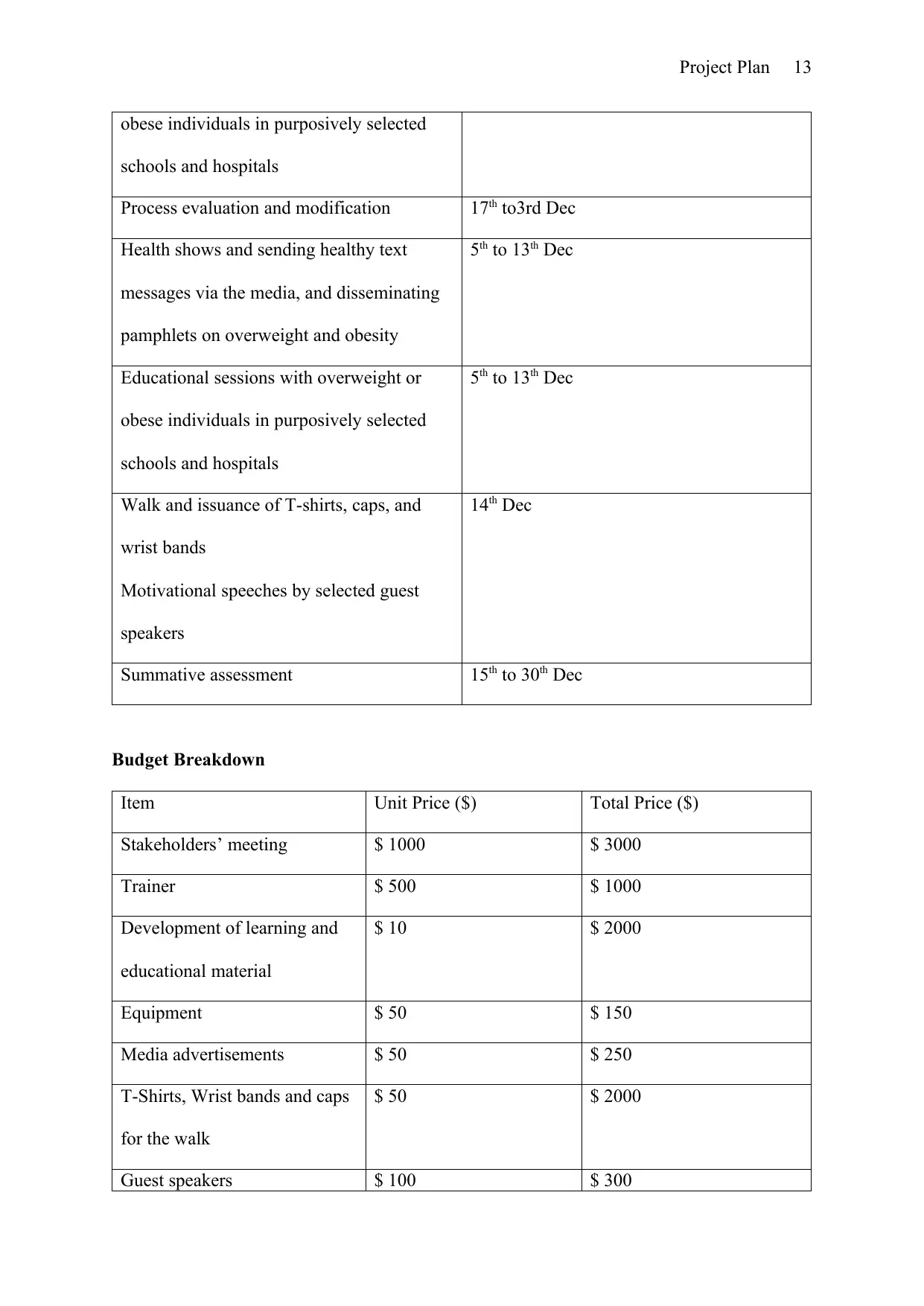
Project Plan 13
obese individuals in purposively selected
schools and hospitals
Process evaluation and modification 17th to3rd Dec
Health shows and sending healthy text
messages via the media, and disseminating
pamphlets on overweight and obesity
5th to 13th Dec
Educational sessions with overweight or
obese individuals in purposively selected
schools and hospitals
5th to 13th Dec
Walk and issuance of T-shirts, caps, and
wrist bands
Motivational speeches by selected guest
speakers
14th Dec
Summative assessment 15th to 30th Dec
Budget Breakdown
Item Unit Price ($) Total Price ($)
Stakeholders’ meeting $ 1000 $ 3000
Trainer $ 500 $ 1000
Development of learning and
educational material
$ 10 $ 2000
Equipment $ 50 $ 150
Media advertisements $ 50 $ 250
T-Shirts, Wrist bands and caps
for the walk
$ 50 $ 2000
Guest speakers $ 100 $ 300
obese individuals in purposively selected
schools and hospitals
Process evaluation and modification 17th to3rd Dec
Health shows and sending healthy text
messages via the media, and disseminating
pamphlets on overweight and obesity
5th to 13th Dec
Educational sessions with overweight or
obese individuals in purposively selected
schools and hospitals
5th to 13th Dec
Walk and issuance of T-shirts, caps, and
wrist bands
Motivational speeches by selected guest
speakers
14th Dec
Summative assessment 15th to 30th Dec
Budget Breakdown
Item Unit Price ($) Total Price ($)
Stakeholders’ meeting $ 1000 $ 3000
Trainer $ 500 $ 1000
Development of learning and
educational material
$ 10 $ 2000
Equipment $ 50 $ 150
Media advertisements $ 50 $ 250
T-Shirts, Wrist bands and caps
for the walk
$ 50 $ 2000
Guest speakers $ 100 $ 300
Paraphrase This Document
Need a fresh take? Get an instant paraphrase of this document with our AI Paraphraser

Project Plan 14
Consumables $ 30 $ 6000
Totals 14700
Consumables $ 30 $ 6000
Totals 14700
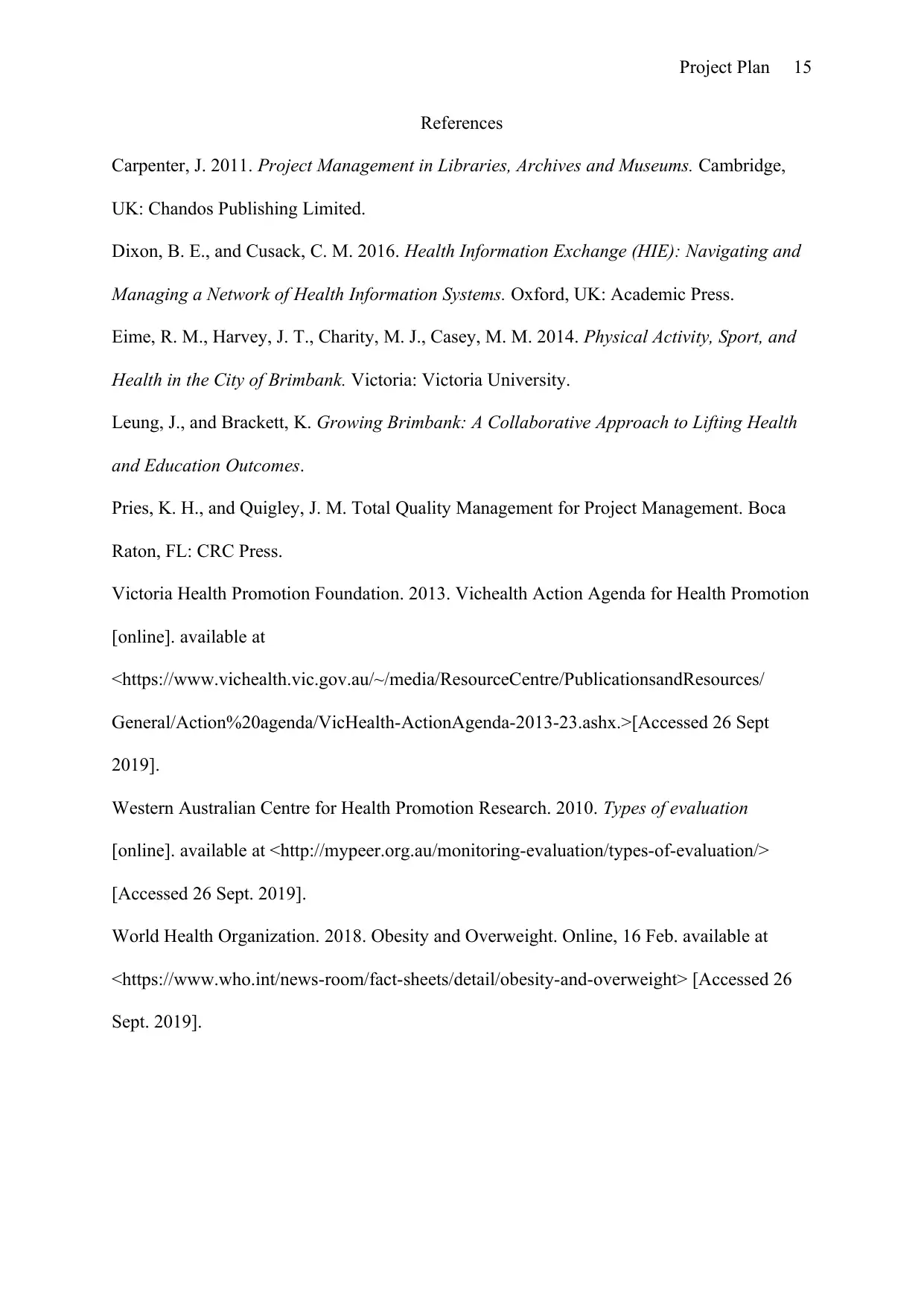
Project Plan 15
References
Carpenter, J. 2011. Project Management in Libraries, Archives and Museums. Cambridge,
UK: Chandos Publishing Limited.
Dixon, B. E., and Cusack, C. M. 2016. Health Information Exchange (HIE): Navigating and
Managing a Network of Health Information Systems. Oxford, UK: Academic Press.
Eime, R. M., Harvey, J. T., Charity, M. J., Casey, M. M. 2014. Physical Activity, Sport, and
Health in the City of Brimbank. Victoria: Victoria University.
Leung, J., and Brackett, K. Growing Brimbank: A Collaborative Approach to Lifting Health
and Education Outcomes.
Pries, K. H., and Quigley, J. M. Total Quality Management for Project Management. Boca
Raton, FL: CRC Press.
Victoria Health Promotion Foundation. 2013. Vichealth Action Agenda for Health Promotion
[online]. available at
<https://www.vichealth.vic.gov.au/~/media/ResourceCentre/PublicationsandResources/
General/Action%20agenda/VicHealth-ActionAgenda-2013-23.ashx.>[Accessed 26 Sept
2019].
Western Australian Centre for Health Promotion Research. 2010. Types of evaluation
[online]. available at <http://mypeer.org.au/monitoring-evaluation/types-of-evaluation/>
[Accessed 26 Sept. 2019].
World Health Organization. 2018. Obesity and Overweight. Online, 16 Feb. available at
<https://www.who.int/news-room/fact-sheets/detail/obesity-and-overweight> [Accessed 26
Sept. 2019].
References
Carpenter, J. 2011. Project Management in Libraries, Archives and Museums. Cambridge,
UK: Chandos Publishing Limited.
Dixon, B. E., and Cusack, C. M. 2016. Health Information Exchange (HIE): Navigating and
Managing a Network of Health Information Systems. Oxford, UK: Academic Press.
Eime, R. M., Harvey, J. T., Charity, M. J., Casey, M. M. 2014. Physical Activity, Sport, and
Health in the City of Brimbank. Victoria: Victoria University.
Leung, J., and Brackett, K. Growing Brimbank: A Collaborative Approach to Lifting Health
and Education Outcomes.
Pries, K. H., and Quigley, J. M. Total Quality Management for Project Management. Boca
Raton, FL: CRC Press.
Victoria Health Promotion Foundation. 2013. Vichealth Action Agenda for Health Promotion
[online]. available at
<https://www.vichealth.vic.gov.au/~/media/ResourceCentre/PublicationsandResources/
General/Action%20agenda/VicHealth-ActionAgenda-2013-23.ashx.>[Accessed 26 Sept
2019].
Western Australian Centre for Health Promotion Research. 2010. Types of evaluation
[online]. available at <http://mypeer.org.au/monitoring-evaluation/types-of-evaluation/>
[Accessed 26 Sept. 2019].
World Health Organization. 2018. Obesity and Overweight. Online, 16 Feb. available at
<https://www.who.int/news-room/fact-sheets/detail/obesity-and-overweight> [Accessed 26
Sept. 2019].
1 out of 15
Related Documents
Your All-in-One AI-Powered Toolkit for Academic Success.
+13062052269
info@desklib.com
Available 24*7 on WhatsApp / Email
![[object Object]](/_next/static/media/star-bottom.7253800d.svg)
Unlock your academic potential
© 2024 | Zucol Services PVT LTD | All rights reserved.





